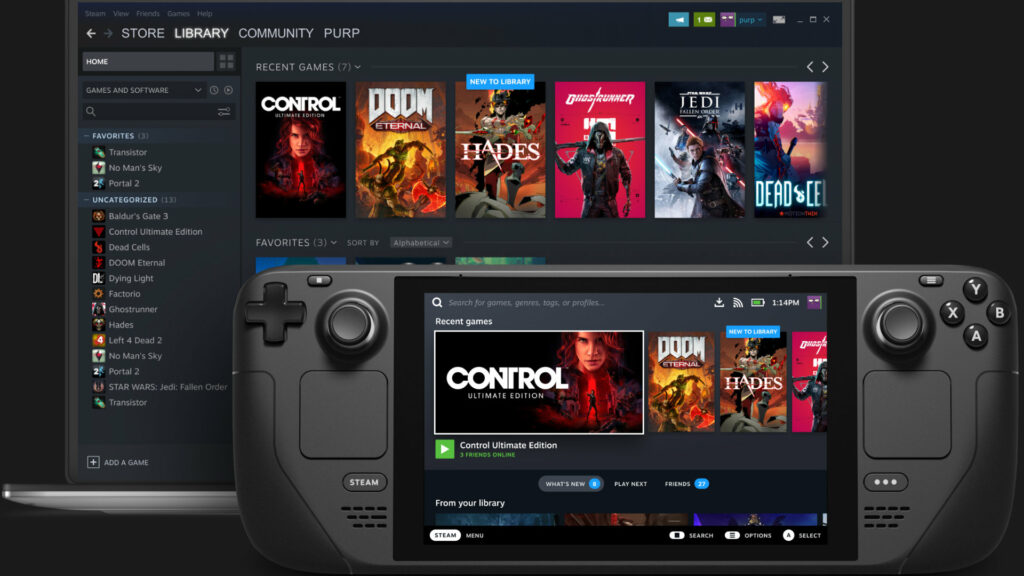
The Steam Deck is an intriguing project. Valve’s handheld console promises to let you play PC games on the go with unparalleled convenience. A promise already made many times by many manufacturers, but which has never really come true.
On July 15, 2021, Valve very quietly announced their brand new handheld console, the Steam Deck. A real gaming PC that fits in the palm of your hand, the device promises to offer access to the entire Steam game catalog on the go, with top fluidity and performance. On paper, the device looks good, but many other companies have tried in the past to sell handheld consoles of the same model. And few have succeeded.
In bulk, we can for example cite the GPD Win 3 or the Aya Neo which, too, had the ambition to put the PC gaming experience in your pocket. Neither has established itself as the benchmark portable console. Could Valve succeed where so many others have failed?
The strength of Steam
The first thing that sets the Steam Deck apart from all other Windows 10 handheld consoles is obviously the corporate strike force behind the console. Valve is a video game giant that has the economic and media resources to establish itself in the market. Rumors about the Steam Deck date back several weeks, and show a certain interest in the console.
The other great strength of the console is obviously the access to the entire Steam game catalog. A must-see virtual store for all PC gamers, Valve’s Store offers access to thousands of games, from the smallest indie nugget to AAA headlines. This is not the first portable console that tries to stick the Steam catalog in the palm of your hand, but here the device is designed, optimized and developed especially for maximum comfort on this platform.
The delicate question of hardware
There is no doubt that Valve will offer an impeccable experience on the Steam Deck, but the console will still have to deal with some limitations inherent in the portable format.
The first is obviously that of autonomy. Running very power-hungry (and therefore very power-hungry) titles on portable equipment risks melting the battery immediately. The 40 Wh battery promises 2 to 8 hours of autonomy depending on the games played on the console. This is significantly less than on a Nintendo Switch which displays between 4:30 and 9 hours of autonomy. To power such a machine, you will also need a solid charger. The Steam Deck is probably not the best device to play for hours on the long vacation road in short.
The console is relatively bulky and its technical sheet contains some oddities. The Steam Deck offers for example an IPS screen and not OLED. The definition of the screen is also limited to 1280 x 800 px, which will not really allow you to take advantage of all the graphic richness of the most advanced games. These choices appear to be Valve’s concessions to keep the console reasonably priced.
Zero portage required
One of the best promises Valve made with the Steam Deck was regarding game compatibility. According to the company, all games on Steam should work without additional development effort on the part of the publishers.

However, the console does not run on Windows (which is traditionally the platform that poses the fewest compatibility problems), but on SteamOS, a home version of Linux. To ensure compatibility with the Steam catalog, Valve used a small tool called Proton. The latter is in fact a compatibility layer that will translate the instructions thought for Windows into a language understandable for the Linux system. The system is similar to the Wine program which will be familiar to anyone who has ever gotten their hands on a Linux system.
The disadvantage of such a solution is that it very often reduces the performance and does not necessarily ensure a perfect equivalence of all the functionalities. Proton, however, appears to be a rather elaborate and well-finished tool. According to the first feedback from IGN, which was able to get its hands on the Steam Deck, performance does not seem to be affected by the use of Proton. If Valve is really successful, we could soon see a host of Linux handheld consoles hit the market.
A console designed for the future?
As we have seen, the Steam Deck has some major challenges to overcome before establishing itself as a portable console worthy of the name. Valve seems to have put in a lot of effort, but it will be up to the public to judge whether a portable gaming PC is really worth it.
Because it should not be forgotten, the Steam Deck is above all a PC. By connecting the device to a screen, we find a very classic desktop interface, with a web browser and various applications. It is even possible to install Windows on the machine.
This versatility, somewhat ignored by Valve, allows us to consider new possibilities with the Steam Deck. Why not install other app stores like the Epic Game Store or the Electronic Arts store? Why not try cloud gaming through Xbox Game Pass? The Steam Deck is a powerful, portable PC capable of running a whole bunch of diverse and varied software. This is perhaps the most exciting aspect of this new device.



